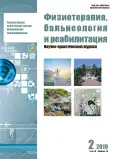High frequency radio wave method in the correction of involute skin changes
- Authors: Yusova Z.Y.1, Akhmedbaeva I.A.2, Likhtareva A.S.1
-
Affiliations:
- Central State Medical Academy of the Administration of the President of the Russian Federation
- “Premium Aesthetics” LLC
- Issue: Vol 18, No 2 (2019)
- Pages: 92-95
- Section: Original studies
- URL: https://journals.rcsi.science/1681-3456/article/view/62448
- DOI: https://doi.org/10.17816/1681-3456-2019-18-2-92-95
- ID: 62448
Cite item
Full Text
Abstract
The study presents data on the impact of the monopolar radiofrequency method on the morphofunctional state of the skin. Patients were observed with various morphotypes of involute skin changes. 49 patients aged 45 to 55 years were observed. All patients were divided into 3 groups depending on the prevailing morphotype of involute skin changes: fine-wrinkled, deformed, and mixed. In all groups, a single exposure was performed using the monopolar radio frequency method according to the approved Protocol of work in the face area. Objective research methods included ultrasound sonography of the epidermis and dermis, adapted dermatological indices of quality of life (DIQ) and SAN (well-being, activity, mood). The results were evaluated 3, 6 and 12 months after the treatment. The obtained data showed that the high-frequency radio-wave method is more effective in deformational and mixed types of aging compared to small-scale wrinkling.
Full Text
##article.viewOnOriginalSite##About the authors
Zhanna Yu. Yusova
Central State Medical Academy of the Administration of the President of the Russian Federation
Author for correspondence.
Email: zyusova@mail.ru
ORCID iD: 0000-0001-6452-2914
SPIN-code: 7637-1663
DSc, Prof.
Russian Federation, MoscowInga A. Akhmedbaeva
“Premium Aesthetics” LLC
Email: zyusova@mail.ru
ORCID iD: 0000-0003-0641-8232
Russian Federation, Moscow
Anzhelika S. Likhtareva
Central State Medical Academy of the Administration of the President of the Russian Federation
Email: zyusova@mail.ru
Russian Federation, Moscow
References
- Alster TS, Tanzi E. Improvement of neck and cheek laxity with a nonablative radiofrequency device: a lifting experience. Dermatol Surg. 2004;30:503-7. doi: 10.1111/j.1524-4725.2004.30164.x.
- Fitzpatrick R, Geronemus R, Goldberg D, et al. Multicenter study of non-invasive radiofrequency for peri-orbital tissue tightening. Lasers Surg Med. 2003;33:232-42. doi: 10.1002/lsm.10225.
- Bogle MA, Ubelhoer N, Weiss RA, et al. Evaluation of the multiple pass, low fluence algorithm for radiofrequency tightening of the lower face. Lasers Surg Med. 2007;39:210-7. doi: 10.1002/lsm.20472.
- Talybova AP, Stenko AG, Korchazhkina NB. Innovative technologies in the treatment of combined cicatrical skin changes. Physiotherapist. 2017;1:47-55. (in Russ.).
- Kruglova LS, Kotenko KV, Korchazhkina NB, Turbovskaya SN. Fizioterapiya v dermatologii [Physiotherapy in dermatology]. Moscow: Geotar-Media; 2016. 303 p. (in Russ.).
- Yusova ZhYu, Potekaev NN, Logina NYu, Zubakhin AG. Classification of involutional changes in the skin. Journal of Experimental and Clinical Dermatocosmetology. 2011;5:3-6. (in Russ.).
- Yusova ZhYu, Solovieva EV, Ivanova MA. Involutional changes of skin and microcirculatory venule. Belgorod State University Scientific Bulletin Medicine Pharmacy. 2012;20(22-2):97-100. (in Russ.).
- Yusova ZhYu. Involutional skin changes with taking into account its type of aging. Belgorod State University Scientific Bulletin Medicine Pharmacy. 2012;20(22-2):83-88. (in Russ.).
- Yusova ZhYu, Kuznecova AO, Sokolova-Merkurieva AV, Klivitskaya NA. Skin recovery following aggressive procedures. Plasticheskaya khirurgiya i kosmetologiya [Plastic Surgery and Cosmetology]. 2013;3:447-453. (in Russ.).
- Yusova ZhYu, Kuznecova AO. A combined method for correction of involutional changes in the skin. Journal of Experimental and Clinical Dermatocosmetology. 2013;5:47-53. (in Russ.).
- Weiss RA, Weiss MA, Munavalli G, et al. Monopolar radiofrequency facial tightening: a retrospective analysis of efficacy and safety in over 600 treatments. J Drugs Dermatol. 2006;5:707-12.
- Fritz M, Counters JT, Zelickson BD. Radiofrequency treatment for middle and lower face laxity. Arch Facial Plast Surg. 2004;6:370-3. doi: 10.1001/archfaci.6.6.370.
- De Felipe I, Del Cueto SR, Perez E, et al. Adverse reactions after nonablative radiofrequency: follow-up of 290 patients. J Cosmet Dermatol. 2007;6:163-6. doi: 10.1111/j.1473-2165.2007.00322.x.
- Narins RS, Tope WD, Pope K, et al. Overtreatment effects associated with a radiofrequency tissue-tightening device: rare, preventable, and correctable with subcision and autologous fat transfer. Dermatol Surg. 2006;32:115-24. doi: 10.1111/1524-4725.2006.32019.
- De Felipe I, Redondo P. Animal model to explain fat atrophy using nonablative radiofrequency. Dermatol Surg. 2007;33:141–5. doi: 10.1111/j.1524-4725.2006.33031.x.
- Abraham MT, Ross EV. Current concepts in nonablative radiofrequency rejuvenation of the lower face and neck. Facial Plast Surg. 2005;21:65-73. doi: 10.1055/s-2005-871765.
- Finzi E, Spangler A. Multipass vector (mpave) technique with nonablative radiofrequency to treat facial and neck laxity. Dermatol Surg. 2005;31:916-22. doi: 10.1111/j.1524-4725.2005.31805.
Supplementary files







